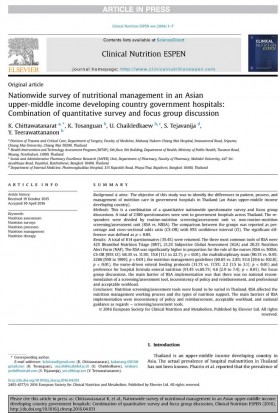This website uses cookies so that we can provide you with the best user experience possible. Cookie information is stored in your browser and performs functions such as recognising you when you return to our website and helping our team to understand which sections of the website you find most interesting and useful.
Nationwide survey of nutritional management in an Asian upper-middle income developing country government hospitals: Combination of quantitative survey and focus group discussion (2016)

รายละเอียดเพิ่มเติม
K. Chittawatanarat a, *, K. Tosanguan b, U. Chaikledkaew b, c, S. Tejavanija d, Y. Teerawattananon b
a Division of Trauma and Critical Care, Department of Surgery, Faculty of Medicine, Maharaj Nakorn Chiang Mai Hospital, Intawarorod Road, Sripume,
Chiang Mai University, Chiang Mai 50200, Thailand
b Health Intervention and Technology Assessment Program (HITAP), 6th floor, 6th Building, Department of Health, Ministry of Public Health, Tiwanon Road,
Muang, Nonthaburi, 11000, Thailand
c Social and Administrative Pharmacy Excellence Research (SAPER) Unit, Department of Pharmacy, Faculty of Pharmacy, Mahidol University, 447 Sri-
Ayudthaya Road, Payathai, Ratchathewi, Bangkok 10400, Thailand
d Department of Internal Medicine, Pharmongkutklao Hospital, 315 Rajavithi Road, Phaya-Thai, Rajathevi, Bangkok 10400, Thailand
Summary
Background & aims: The objective of this study was to identify the differences in pattern, process, and management of nutrition care in government hospitals in Thailand (an Asian upper-middle income developing country).
Methods: This is a combination of a quantitative nationwide questionnaire survey and focus group discussions. A total of 2300 questionnaires were sent to government hospitals across Thailand. The responders were divided by routine-nutrition screening/assessment unit vs. non-routine-nutrition screening/assessment unit (RSA vs. NRSA). The comparison between the groups was reported as percentage and cross-sectional odds ratio (CS-OR) with 95% confidence interval (CI). The significant difference was defined as p < 0.05.
Results: A total of 814 questionnaires (35.4%) were returned. The three most common tools of RSA were 42% Bhumibol Nutrition Triage (BNT), 21.2% Subjective Global Assessment (SGA) and 20.2% Nutrition Alert Form (NAF). The RSAwas significantly higher in proportion for the role of the nurses (RSA vs. NRSA; CS-OR [95% CI]: 68.3% vs. 11.9%; 15.8 [11.1 to 22.7]; p < 0.01), the multidisciplinary team (90.1% vs. 0.4%; 2266 [558 to 1909]; p < 0.01), the nutrition management guidelines (60.6% vs. 2.8%; 53.6 [29.6 to 102.8]; p < 0.01), the nurse-driven enteral feeding protocols (31.7% vs. 17.5%; 2.2 [1.5 to 3.1]; p < 0.01) and preference for hospital formula enteral nutrition (91.4% vs.69.7%; 4.6 [2.9 to 7.4]; p < 0.01). For focus group discussions, the main barrier of RSA implementation was that there was no national recommendation of a screening/assessment tool, inconsistency of policy and reimbursement, and professional and acceptable workload.
Conclusion: Nutrition screening/assessment tools were found to be varied in Thailand. RSA affected the nutrition management working process and the types of nutrition support. The main barriers of RSA implementation were inconsistency of policy and reimbursement, acceptable workload, and national guidance as regards e screening/assessment tools.
Full Text: http://www.clinicalnutritionespen.com/article/S2405-4577(16)30212-1/abstract




